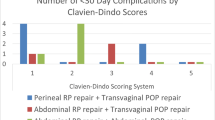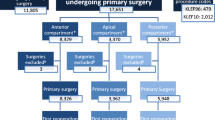PURPOSE
This study was designed to determine what impact surgical technique, means of access, and method of rectopexy have on recurrence rates following abdominal surgery for full-thickness rectal prolapse.
METHODS
Consecutive individual patient data on age, gender, surgical technique (mobilization-only, mobilization-resection-pexy, or mobilization-pexy), means of access (open or laparoscopic), rectopexy method (suture or mesh), follow-up length, and recurrences were collected from 15 centers performing abdominal surgery for full-thickness rectal prolapse between 1979 and 2001. Recurrence was defined as the presence of full-thickness rectal prolapse after abdominal surgery. Chi-squared test and Cox proportional hazards regression analysis were used to assess statistical heterogeneity. Recurrence-free curves were generated and compared using the Kaplan–Meier method and log-rank test, respectively.
RESULTS
Abdominal surgery consisted of mobilization-only (n = 46), mobilization-resection-pexy (n = 130), or mobilization-pexy (n = 467). There were 643 patients. After excluding center 8, there was homogeneity on recurrence rates among the centers with recurrences (n = 8) for age (hazards ratio, 0.6; 95 percent confidence interval, 0.2–1.7; P = 0.405), gender (hazards ratio, 0.6; 95 percent confidence interval, 0.1–2.3; P = 0.519), and center (hazards ratio, 0.3; 95 percent confidence interval, 0.1–1.5; P = 0.142). However, there was heterogeneity between centers with (n = 8) and without recurrences (n = 6) for gender (P = 0.0003), surgical technique (P < 0.0001), means of access (P = 0.01), and rectopexy method (P < 0.0001). The median length of follow-up of individual centers varied from 4 to 127 months (P < 0.0001). There were 38 recurrences at a median follow-up of 43 (range, 1–235) months. The pooled one-, five-, and ten-year recurrence rates were 1.06, 6.61, and 28.9 percent, respectively. Age, gender, surgical technique, means of access, and rectopexy method had no impact on recurrence rates.
CONCLUSIONS
Although this study is likely underpowered, the impact of mobilization-only on recurrence rates was similar to that of other surgical techniques.



Similar content being viewed by others
REFERENCES
M Brazzelli P Bachoo A Grant (2000) ArticleTitleSurgery for complete rectal prolapse in adults Cochrane Database Syst Rev 2 CD001757 Occurrence Handle10796816
B Rosner (1990) Fundamentals of biostatistics EditionNumber3rd ed PWS-KENT Publishing Company Boston
DR Cox (1972) ArticleTitleRegression methods and life tables J R Stat Soc B 34 187–220
EL Kaplan P Meier (1958) ArticleTitleNonparametric estimation from incomplete observations J Am Stat Assoc 53 457–81
CL Vale JF Tierney LA Stewart (2002) ArticleTitleEffects of adjusting for censoring on meta-analyses of time-to-event outcomes Int J Epidemiol 31 107–1 Occurrence Handle10.1093/ije/31.1.107 Occurrence Handle11914304
N Mantel W Haenszel (1959) ArticleTitleStatistical aspects of the analysis of data from retrospective studies of disease J Natl Cancer Inst 22 719–48 Occurrence Handle1:STN:280:CyaD1cvnt1M%3D Occurrence Handle13655060
R Nelson J Spitz RK Pearl H Abcarian (2001) ArticleTitleWhat role does full rectal mobilization alone play in the treatment of rectal prolapse? Tech Coloproctol 5 33–5 Occurrence Handle1:STN:280:DC%2BD38%2FmsF2lsQ%3D%3D Occurrence Handle11793258
GS Duthie DC Bartolo (1992) ArticleTitleAbdominal rectopexy for rectal prolapse: a comparison of techniques Br J Surg 79 107–13 Occurrence Handle1:STN:280:By2B3cfmslQ%3D Occurrence Handle1555053
J Sayfan M Pinho J Alexander-Williams MR Keighley (1990) ArticleTitleSutured posterior abdominal rectopexy with sigmoidectomy compared with Marlex rectopexy for rectal prolapse Br J Surg 77 143–5 Occurrence Handle2317672
K Azimuddin IT Khubchandani L Rosen JJ Stasik RD Riether JF Reed SuffixIII (2001) ArticleTitleRectal prolapse: a search for the “best” operation Am Surg 67 622–7 Occurrence Handle1:STN:280:DC%2BD3MzpvFygtg%3D%3D Occurrence Handle11450773
MJ Solomon CJ Young AA Eyers RA Roberts (2002) ArticleTitleRandomized clinical trial of laparoscopic versus open abdominal rectopexy for rectal prolapse Br J Surg 89 35–9 Occurrence Handle1:STN:280:DC%2BD387hvVCntg%3D%3D Occurrence Handle11851660
MV Kairaluoma MT Viljakka IH Kellokumpu (2003) ArticleTitleOpen vs. laparoscopic surgery for rectal prolapse: a case-controlled study assessing short-term outcome Dis Colon Rectum 46 353–60
ACKNOWLEDGMENT
The authors thank Nilesh Patel, M.D. for having presented the paper at the meeting of The American Society of Colon and Rectal Surgeons, Dallas, Texas, May 8 to 13, 2004.
Author information
Authors and Affiliations
Consortia
About this article
Cite this article
Raftopoulos, Y., Senagore, A., Di Giuro, G. et al. Recurrence Rates After Abdominal Surgery for Complete Rectal Prolapse: A Multicenter Pooled Analysis of 643 Individual Patient Data. Dis Colon Rectum 48, 1200–1206 (2005). https://doi.org/10.1007/s10350-004-0948-6
Published:
Issue Date:
DOI: https://doi.org/10.1007/s10350-004-0948-6




